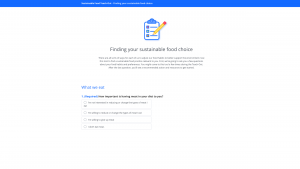Deirdre Lee, Communications Writing Fellow
Identifying a problem is part of addressing an issue, but finding a solution to that issue is more important and difficult to execute — especially when the issue has multiple solutions. That’s why teams at the Center for Academic Innovation created a new software tool called the “Recommender Tool.”
The “Recommender Tool” is a series of questions designed to guide a learner to a specific action that best suits their individual, self-reported needs. The tool gathers a learner’s responses from a series of questions to recommend future courses of action.
Benjamin Morse, Design Manager, supports the University of Michigan Teach-Out Series and manages the Teach-Out development process from conception to launch. He said he wanted to provide a personalized call-to-action for Teach-Out participants.
Morse saw an opportunity to address the problem space when designing the “Sustainable Food Teach-Out” and collaborated with other teams within Academic Innovation to create and implement the “Recommender Tool” in the Teach-Out.
“The ‘Recommender Tool’ specifically is designed to better understand how our learners are coming into this particular Teach-Out experience and gauge a few metrics throughout the entirety of the Teach-Out learning experience so that, at the end, we’re able to give them a more tailored call-to-action,” Morse said.
Using the tool, Teach-Out participants were asked five questions related to food sustainability — such as willingness to change a behavior, how much food waste the learner created, and their confidence in skills like composting. Based on each learner’s unique answers, the tool guided them to one of the ten different actions they could take to reduce their food-related impact on the environment.
“The goal of the tool is to reduce the friction that a learner has as they’re going through the Teach-Out, reduce the cognitive burden of them having to sort through a lot of different actions and make it more personalized, so [we’re having] the action actually mean something to their own personal context and personal lives,” Morse said.
Nathan Magyar, User Experience Designer, developed the visual appearance for the tool. He said he emphasized the importance of customized recommendations for learners through the design of the user experience.
“We follow a user-centered design philosophy here, so we think about who the learner is and what their goals are and what they want to be getting out of the tool, or the experience,” Magyar said. “We make sure that everything that we design supports that.”
 In addition to the user-centered design philosophy, Magyar also said tools — including the “Recommender Tool” — are designed to be generalizable and adaptable so they can be used in other courses. He said although the content would differ according to the subject, the underlying functionality of the tool would remain consistent from course to course.
In addition to the user-centered design philosophy, Magyar also said tools — including the “Recommender Tool” — are designed to be generalizable and adaptable so they can be used in other courses. He said although the content would differ according to the subject, the underlying functionality of the tool would remain consistent from course to course.
Michael Wheeler, Software Developer, said the tool is technologically flexible enough to integrate with online learning experiences on Coursera or edX, two of the university’s partner platforms to deliver online courses and Teach-Outs. However, he said he faced several implementation challenges along the way.
“The most challenging thing about a project [like the ‘Recommender Tool’] is coming up with a data model to represent the relationship between the choice that people make and the questions and options that we’re recommending to them,” Wheeler said.
Additionally, he said determining a workflow capable of walking learners through the selection process and providing recommendations was problematic.
 To overcome these challenges, Wheeler approached the “Recommender Tool” like a survey.
To overcome these challenges, Wheeler approached the “Recommender Tool” like a survey.
“The way we’ve implemented it has allowed us to do it in sections that occur at different points throughout the course and so the questions can be relevant to some content that you’ve just completed,” Wheeler said.
Molly Maher, Behavioral Scientist, crafted the questions and recommendations for the tool. She hoped by providing tailored feedback and guided recommendations, the tool would help to reduce psychological barriers preventing learners from taking action.
“From a behavioral [science] standpoint, the biggest benefit is getting something that’s relevant to you and avoiding choice overload, and in that way, we’re hoping to activate behavior,” Maher said.
Activating behavior is the goal of the Teach-Out Series, according to Morse, who hopes the “Recommender Tool” will equip learners to take action in their communities.
“We’ve been thinking through, ‘how can we better organize and tailor the calls-to-action for a really broad audience of non-experts?’” he said. “I think that’s key where we’re not really designing for one type of learner. We’re really designing for a really broad audience to come in and to get something out of this learning experience.”


